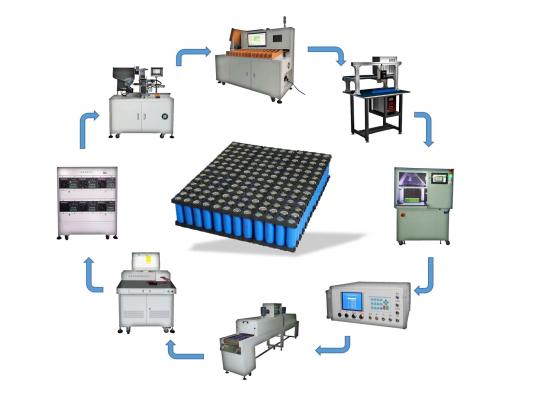LiFePO4 Cells Pack Assembly Line: Optimizing the Manufacturing Process for Lithium Iron Phosphate Batteries
As demand for safer, more efficient, and durable energy storage solutions continues to rise,LiFePO4 (Lithium Iron Phosphate) cells have become a popular choice for electric vehicles (EVs), renewable energy systems, and portable electronics. To meet this growing demand, the EV Bike Battery Assembly plays a crucial role in automating and streamlining the production process, ensuring high-quality battery packs that are safe, reliable, and consistent.
In this blog, we will explore the key components of a LiFePO4 battery pack assembly line, the processes involved, and the benefits of automating battery production.
●What is LiFePO4?
LiFePO4 is a type of lithium-ion battery known for itslong cycle life,thermal stability, andsafety. Compared to other lithium-ion chemistries, LiFePO4 batteries are less prone to overheating and are highly resistant to thermal runaway, making them ideal for applications where safety is critical. These cells are widely used in:
-Electric vehicles (EVs)
-Solar energy storage systems
-Backup power supplies
-Portable electronics
LiFePO4 batteries also offer benefits such as faster charging times, high discharge rates, and environmental sustainability.
●Overview of LiFePO4 Battery Pack Assembly Line
ALiFePO4 cells pack assembly line automates the process of assembling individual LiFePO4 cells into battery packs, ensuring consistency, precision, and efficiency. The assembly line incorporates various stages, from cell preparation to final testing, to ensure that each battery pack meets industry standards.
Key Steps in the LiFePO4 Battery Pack Assembly Process:
1.Cell Sorting and Matching
2.Welding and Interconnection
3.Cell Stacking or Pouch Assembly
4.Module Assembly
5.Battery Management System (BMS) Integration
6.Battery Pack Housing
7.Testing and Inspection
8.Labeling and Packaging
Let’s explore each of these steps in more detail.
●1. Cell Sorting and Matching
The first step in the LiFePO4 battery pack assembly process iscell sorting. Individual cells are measured for key parameters such asvoltage,capacity, andinternal resistance. Cells with similar characteristics are grouped together to ensure consistent performance across the entire pack.
-Importance of Cell Matching: Mismatched cells can lead to uneven charging and discharging, reducing the lifespan of the battery pack. Proper matching ensures optimal performance and safety.
●2. Welding and Interconnection
Once the cells are sorted, the next step is toweld and interconnect the cells. Cells are typically connected in series or parallel configurations, depending on the desired voltage and capacity of the final battery pack.
-Series Configuration: Increases voltage by connecting the positive terminal of one cell to the negative terminal of another.
-Parallel Configuration: Increases capacity by connecting the positive terminals of multiple cells together, and the negative terminals together.
The interconnection process often involvesspot welding orultrasonic welding to create strong, reliable bonds between cells. Automation ensures that the connections are consistent and precise, minimizing the risk of weak connections that could lead to performance issues or safety hazards.
●3. Cell Stacking or Pouch Assembly
In this step, the individual LiFePO4 cells are assembled intostacks orpouches depending on the type of battery being produced. This step is crucial for ensuring that the cells are aligned and properly packed to maximize energy density and maintain the structural integrity of the battery pack.
-Pouch Cells: These are stacked and sealed in flexible pouches to form the final battery pack. Pouch cells are lightweight and can be customized to different shapes and sizes, making them suitable for portable electronics.
-Cylindrical or Prismatic Cells: These types of cells are stacked in a rigid structure and are commonly used in EV batteries.
●4. Module Assembly
Once the cells are stacked, they are grouped intomodules. A module is essentially a collection of cells that are connected in series or parallel to create a building block for the final battery pack. By grouping cells into modules, manufacturers can scale the battery pack to meet the desired voltage and capacity requirements.
The module assembly process includes:
-Cell interconnection within the module.
-Insulation and protection to prevent short circuits.
-Temperature sensors and cooling mechanisms to regulate heat.
●5. Battery Management System (BMS) Integration
TheBattery Management System (BMS) is one of the most critical components of a LiFePO4 battery pack. The BMS monitors and controls the performance of the battery pack, ensuring that each cell operates within safe limits.
-Functions of the BMS:
- Monitorscell voltage andtemperature.
- Balances the cells to ensure uniform charging and discharging.
- Protects the battery pack fromovercharging,over-discharging, andoverheating.
- Provides safety features such asthermal management andshort-circuit protection.
Integrating the BMS into the battery pack ensures that the pack operates safely and efficiently, extending its lifespan and preventing potential safety hazards.
●6. Battery Pack Housing
After the modules and BMS are assembled, the battery pack is enclosed in a protectivehousing. The housing is designed to protect the cells from external factors such asmoisture,dust, andphysical impact. The housing also provides mechanical support and stability to the battery pack, ensuring that it can withstand vibrations and shocks during operation.
Materials used for battery pack housings include:
-Plastic for lightweight applications.
-Aluminum for increased strength and thermal management.
-Steel for heavy-duty applications like EVs.
●7. Testing and Inspection
Once the battery pack is assembled, it undergoes rigoroustesting and inspection to ensure it meets performance and safety standards. Some key tests include:
-Voltage and capacity testing: Ensures that the battery delivers the expected energy output.
-Thermal testing: Verifies that the battery can operate safely across a range of temperatures.
-Shock and vibration testing: Simulates real-world conditions to ensure that the battery is durable and reliable.
-Safety testing: Ensures the battery pack does not overheat, short-circuit, or suffer from thermal runaway.
●8. Labeling and Packaging
After the battery pack passes the testing phase, it is labeled with important information such asspecifications,safety warnings, andmanufacturer details. The battery packs are then packaged and prepared for shipment to customers or assembly into larger systems.
●Benefits of Automation in LiFePO4 Battery Pack Assembly
Automating the LiFePO4 battery pack assembly line offers several key benefits:
1.Improved Efficiency
Automation significantly speeds up the production process, allowing manufacturers to meet high demand without sacrificing quality. Automated systems can assemble thousands of cells into battery packs with minimal human intervention.
2.Consistency and Precision
Automated systems ensure that each battery pack is assembled with the same level of precision and consistency. This reduces the likelihood of defects or failures in the final product, improving reliability and performance.
3.Cost Reduction
By reducing labor costs and minimizing the risk of human error, automation helps manufacturers reduce overall production costs. This is particularly important in the highly competitive energy storage market.
4.Enhanced Safety
Automating the assembly process reduces the risk of accidents or safety issues that can occur during manual assembly. Automated systems are designed to follow strict safety protocols, minimizing the risk of mishandling or improper assembly of hazardous materials.
●Conclusion
TheLiFePO4 cells pack assembly line is a critical component of modern battery manufacturing, enabling the efficient production of high-quality battery packs for a wide range of applications. By automating key processes such as cell sorting, welding, BMS integration, and testing, manufacturers can ensure that their battery packs meet the highest standards of safety, performance, and durability.
As the demand for LiFePO4 batteries continues to grow in industries such as electric vehicles, renewable energy, and consumer electronics, the role of automated assembly lines will become even more important in delivering reliable, high-performance energy storage solutions.

 es
es en
en fr
fr de
de ru
ru pt
pt ko
ko tr
tr pl
pl th
th







 Compatible con red IPv6
Compatible con red IPv6